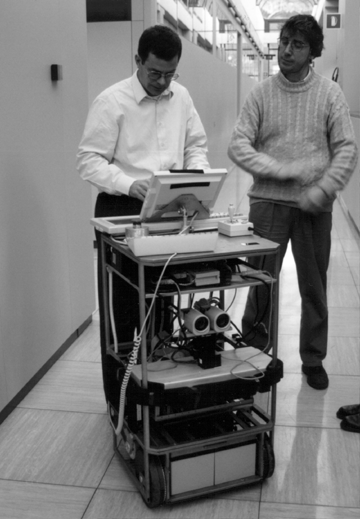
Visitor: Keiichi Ito (TRC Research Planning Department) Period: November 17 - 26, 1995 (10 days) Places: Instituo per la Ricerca Sentifica e Tecnologica (IRST, Italy), Swedish Institute of Computer Science (SICS, Sweden), Research Institute for Symbolic Computation-Linz (RISC-Linz, Austria)
I traveled to Europe to visit the above institutes and find out about current conditions and discuss the future direction of their research.
The Swedish Institute of Computer Science (SICS) is one of Overseas Distributed Laboratories and the other two are overseas subcontractors.
All the three institutes are involved in the basic study of robotics, and I had the briefing on their current activities and enjoyed the demonstrations of their experimental models.
IRST is located in Trento, northern Italy. The location is blessed with natural beauty, commanding a fine view of the Dolomite Alps.
Researchers at IRST are engaged in the study of two types of self-control robot technology, binocular-control and sensor-control robots. They have already developed study models and showed us demonstrations. In the demo, the binocular-type robot proved its capability to check and control its position and posture as it proceeded to a destination, bypassing obstacles on the way. Although both models showed the need for more refinement, we received an impression that the research has progressed satisfactorily.

The Swedish Institute of Computer Science (SICS) is located in Kista, a town in the suburbs of Stockholm. Found in the neighborhood are corporate research centers including Ericsson's. The SICS has two RWC laboratories: one is involved in the development of novel function systems and the other is engaged in neuro-computing. Because Neural Systems SICS Laboratory participated in the RWC project in 1994, they are still in the simulation phase. It seemed, however, that they were now ready for finalizing their research policy and ideas. The research subject of Novel Functions SICS Laboratory is the "snake-type" robot consisting of multiple self-control agents. They are in the process of constructing a prototype after the simulation phase. Dr. Nilsson served as a guide for me and explained using good Japanese that he learned while he was a student at University of Tokyo. He said that in his next trip to Japan he would like to take a prototype with him for demonstrations. I found a poster in the SICS which read "To Understand, To Be Conscious, To Memorize"in Japanese that Dr. Nilsson designed.

RISC-Linz is located in the suburbs of Linz, Austria. The building looked like an old castle, showing the long history of the country. The research theme of RISC-Linz as a subcontractor of RWCP is the development of neural network-based, technology-independent program. They have already finished the development and simulation of the program and will soon start integrating it into an actual system. My personal impression was that they would achieve definite results by the end of March 1996.
It seemed that the researchers of the three institutes were enjoying their research work in this superb environment. I believe we can look forward to the results of their activities.